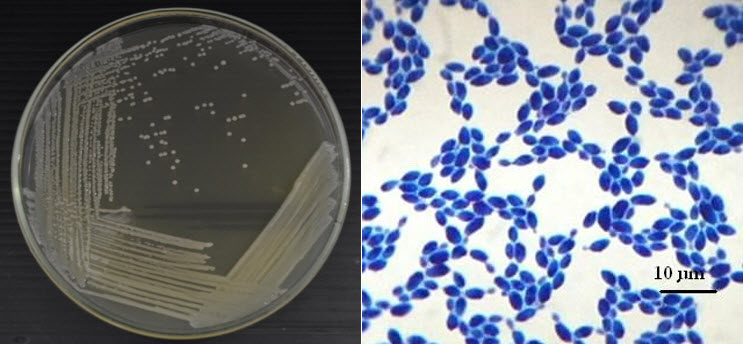การวิเคราะห์และเปรียบเทียบยีสต์บีตากลูแคนจากลูกแป้งข้าวหมากในภาคกลางของประเทศไทย
Main Article Content
Abstract
Arun Chanchaichaovivat, Somkiat Phornphisutthimas and Kredkaew Mookseang
รับบทความ: 13 กรกฎาคม 2558; ยอมรับตีพิมพ์: 27 ตุลาคม 2558
บทคัดย่อ
การวิจัยนี้มีวัตถุประสงค์เพื่อวิเคราะห์และเปรียบเทียบปริมาณบีตากลูแคนจากเซลล์ยีสต์ที่แยกได้จากลูกแป้งข้าวหมากซึ่งทำในจังหวัดอ่างทอง อยุธยา สระบุรี และลพบุรี ได้แก่ Candida sp. ATY1 Candida sp. AUY3 C. quercitrusa SRY4 Pichia kudriavzevii LBY2 และข้าวหมากที่ทำในห้องปฏิบัติการ การวิเคราะห์ปริมาณบีตากลูแคนในผนังเซลล์ยีสต์และข้าวหมากใช้วิธีสเปกโทรโฟโทเมทรี (spectrophotometry) ที่ความยาวคลื่น 510 นาโนเมตร ตรวจวัดระดับปริมาณยีสต์บีตากลูแคน ที่อุณหภูมิห้อง ระยะเวลาการบ่ม 24 48 72 และ 96 ชั่วโมง จากผลการวิจัยพบว่า ยีสต์สายพันธุ์ Candida sp. ATY1 Candida sp. AUY3 C. quercitrusa SRY4 Pichia kudriavzevii LBY2 และข้าว-หมากมีปริมาณบีตากลูแคนในปริมาณสูงสุดที่ร้อยละ 75.1 71.7 75.1 71.9 และ 2.6 ตามลำดับ แนวโน้มการสร้างบีตากลูแคนสูงสุดอยูู่ที่ 72 – 96 ชั่วโมง ซึ่งยีสต์ทั้ง 4 สายพันธุ์อาจใช้เป็นแหล่งทางเลือกสำหรับผลิตบีตากลูแคนในระดับการค้าได้ในอนาคต
คำสำคัญ: ข้าวหมาก บีตากลูแคน Candida sp. ATY1 Candida sp. AUY3
Candida quercitrusa SRY4 Pichia kudriavzevii LBY2
Abstract
The objectives of this research were to analyze and compare β-glucan contents of yeast isolates from Angthong, Ayutthaya, Saraburi and Lopburi provinces including Candida sp. ATY1, Candida sp. AUY3, C. quercitrusa SRY4, Pichia kudriavzevii LBY2 and Kao–Mak made in the laboratory. β-glucan from yeasts’ cell walls were analysed by spectrophotometric method with wave length of 510 nm. The samples were incubated at room temperature for 24, 48, 72 and 96 hours. The results showed that Candida sp. ATY1, Candida sp. AUY3, C. quercitrusa SRY4, Pichia kudriavzevii LBY2 and Kao–Mak synthesized maximum β-glucan at 75.1%, 71.7% 75.1%, 71.9% and 2.6%, respectively. All sample produced β-glucan in the highest level at an incubation time range of 72–96 hours. In the future, these 4 yeast strains may be alternative resources for β-glucan production in the commercial uses.
Keywords: Kao-Mak, β-glucan, Candida parapsilosis ATY1, Candida parapsilosis AUY3, Candida quercitrusa SRY4, Pichia kudriavzevii LBY2
Downloads
Article Details

This work is licensed under a Creative Commons Attribution-NonCommercial 4.0 International License.
References
Chachaichaovivat, A. (2010). Yeast betaglucan: Food supplement for immune system. Journal of Research Unit on Science, Technology and Environment for Learning 1(2): 113–118. (in Thai)
Chanchaichaovivat, A. (2012). Yeast probiotic. Journal of Research Unit on Science, Technology and Environment for Learning 3(1): 72–79. (in Thai)
Chanchaichaovivat, A., and Pasuk, A. (2013). Inhibitory effect of fermented glutinous rice on enteropathogenic bacteria. The Journal of Interdisciplinary Networks 2(2): 30–36.
Dellinger, E. P., Babineau, T. J., Bleicher, P., Kaiser, A. B., Seibert, G. B., Postier, R. G., Vogel, S. B., Norman, J., Kaufman, D., Galandiuk, and Condon, R. E. (1999). Effect of PGG-glucan on the rate of serious postoperative infection or death observed after high-risk gastrointestinal operations. Betafectin Gastrointestinal Study Group. Archives of Surgery 134(9): 977–983.
Demir, G., Klein, H. O., Mandel-Molinas, N., and Tuzuner, N. (2007). Beta glucan induces proliferation and activation of monocytes in peripheral blood of patients with ad-vanced breast cancer. International im-munopharmacology 7(1): 113–116.
Fuller, R. (2010). The Importance of Innate Immune Function in Disease Manage-ment and Prevention: 1-3, 1-6 Beta glu-can Supplementation Advice. Retrieved from Web site: http://www.doveclinic.com/ downloads/.../ImmiflexDoveWebsiteInfo.pdf, May 3, 2010.
Hong, F., Yan, J., Baran, J. T., Allendorf, D. J., Hansen, R. D., Ostroff, G R., Xing, P. X., Cheung, N. K., and Ross, G. D. (2004). Mechanism by which orally administered β-1,3-glucans enhance the tumoricidal activity of antitumor monoclonal antibodies in murine tumor models. Journal of Immunology 173(2): 797–806.
Kogan, G., Stasko, A., Bauerova, K., Polovka, M., Soltes, L., Brezova, V., and Navarova, J. (2005). Antioxidant properties of yeast (1,3)-β-D-glucan studied by electron paramagnetic resonance spectroscopy and its activity in the adjuvant arthritis. Carbohydrate Polymers 61(1): 18–28.
Megazyme. (2011). Enzymatic yeast beta-glucan. Ireland: Megazyme International.
Onderdonk, A. B., Cisneros, R. L., Hinkson, P., and Ostroff, G. (1992). Anti-infective effect of poly-beta 1-6-glucotriosyl-beta 1-3-gluco pyranose glucan in vivo. Infection and Immunity 60(4): 1642–1647.
The National Innovation Agency (NIA). (2005). Yeast Products. Chonburi, Thailand.
